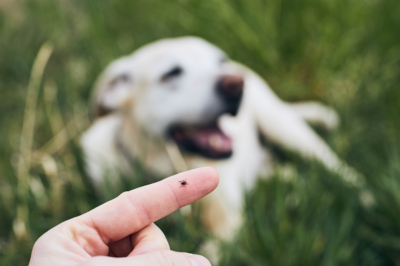
After a long winter and spring finally on the horizon, we come out of “hibernation” and begin to make summer plans. But, as the temperature warms and the sun shines bright, ticks become active. Learn about ticks and what you can do to prevent them from becoming a “hitchhiker” on your pet.
What you need to know:
- Ticks are not insects. They are actually arachnids, belonging to the same family as spiders and mites.
- Ticks cannot fly or jump. They wait on tips of grass, shrubs, and leaf litter where they sense vibrations, odors, changes in temperature, and light patterns that occur when animals (including people) walk past. The tick then extends its legs and grabs on to the passerby.
- Ticks survive by feeding on the blood of birds and mammals such as deer, mice, dogs, cats, and humans.
- Ticks DO NOT die in the winter. They overwinter under the snow, in the leaf litter and brush where the temperature is warmer than the air temperature. They can survive temperatures down to -4°F (-20°C).
- As soon as the air temperature hits 39°F (4°C), ticks become active and begin looking for a meal.
- Ticks live mostly in wooded areas but can also be found in cities because they “hitch” rides on birds, mice, and deer. They can be found in parks, greens spaces such as trails, and backyards.
- There are over 15 species of ticks in North America. The most common species are the American Dog Tick, the Deer Tick (also known as the Blacklegged Tick), the Brown Dog Tick, and the Lone Star Tick.
- Some ticks can cause serious and deadly illnesses (e.g., the Blacklegged Tick can transmit Lyme disease).
- Blacklegged Ticks are expanding their range from year to year, largely due to climate change. Just because your area did not have ticks last year does not mean that it won’t this year. In parts of Canada, the rate of expansion is about 46km (nearly 30 miles) per year.
- Ticks can be found in every state in the United States and in many parts of Canada.
- Ticks can survive droughts – a hot, dry summer does not mean there will be fewer ticks around.
What you can do:
- Start tick prevention BEFORE your pets are exposed. Your veterinarian will help you choose the best product(s) for your pet depending on where you live.
- Ask your veterinarian if the Lyme disease vaccine is available or recommended for your dog.
- Avoid areas where ticks live to avoid exposing your dog (and yourself). The blacklegged tick prefers moist habitats, such as leaf litter. The American dog tick (wood tick) prefers drier habitats, such as tall grasses.
- Check your pets for ticks on a daily basis. Run your fingers gently but firmly through your pet’s coat, checking for any new bumps on the skin. Start at the head and work your way over the entire body, under the collar, in the ears, and between the toes. If you find a tick, follow the directions below or see your veterinarian to remove it. Be sure to check yourself too!
- If you see signs of Lyme disease in your cat (fever, loss of appetite, pain, stiffness, lameness, fatigue, sudden collapse, or trance-like behavior) or your dog (fever, loss of appetite, pain, sudden lameness or signs of arthritis, fatigue, or swollen joints or lymph nodes ), contact your veterinarian.
- Do NOT use home remedies, such as applying petroleum jelly or touching the rear of the tick with a match, to remove ticks. These methods can cause the tick to salivate and will actually increase the risk of transmitting disease to your pet.
- Clean up areas of your yard that make good tick habitat. Rake leaves, keep grass short, and trim around trees and beneath hedges.
How to remove a tick:
You will need:
- Fine-tipped tweezers
- Disposable gloves
- Soap and water
- A small container, rubbing alcohol, and marker
Directions:
- Put on gloves. Infectious bacteria may be passed through breaks in the skin simply by handling ticks.
- Grasp the tick close to the skin. Use the fine-tipped tweezers to grasp the tick as close to your pet’s skin as possible without pinching your pet’s skin. DO NOT TWIST OR JERK THE TICK. This may cause the mouthparts of the tick to break off and remain in the skin, which will increase the chance of infection.
- Pull slowly. Pull the tick slowly and gently using steady, firm pressure. Do not squeeze the tick. It may take several seconds for the tick to release its hold. Contact your veterinarian if you have difficulty removing the tick.
- Save the tick. Place the tick in a small container with rubbing alcohol. Label the container with the date and geographical location where the tick bite occurred.
- Wash. Wash the bite area with soap and water to disinfect it. You can also apply an antibiotic ointment (e.g., Polysporin) to the area. After removing your gloves, wash up as an extra safety precaution.
- Monitor. Monitor the bite site for signs of infection, such as swelling, redness, tenderness, and pus. Contact your veterinarian if you have any concerns.
- Go to your veterinarian. Bring the preserved tick to your veterinarian to test it for disease. Your veterinarian will help you start a tick prevention program for your pet.
